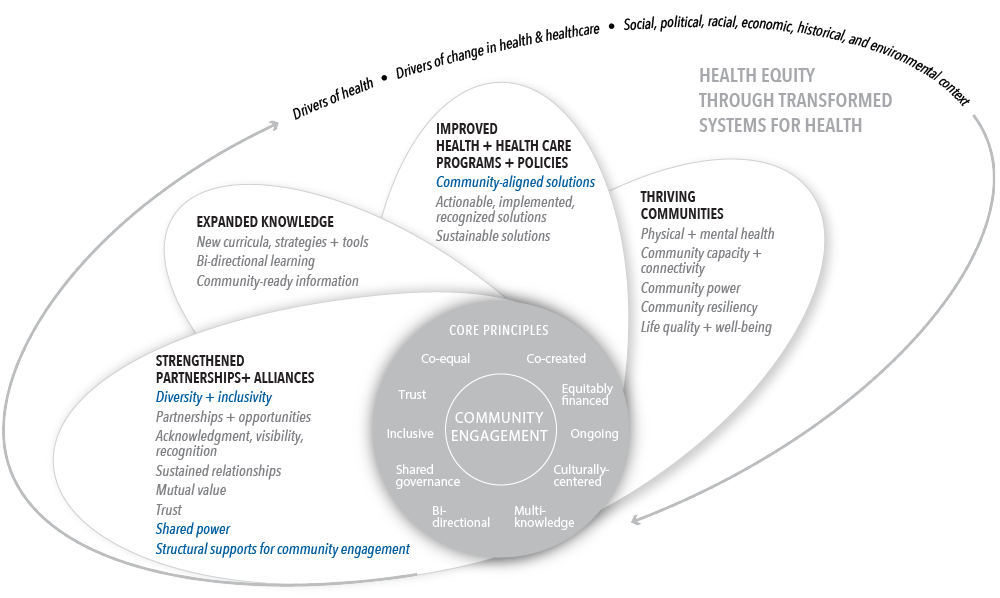Assessing Meaningful Community Engagement
Community Engagement in Research Index
KEY FEATURES
COMMUNITY/ GEOGRAPHY
Academic partners
Community partners
Mental health
Substance abuse
Behavioral health
United States
COMMUNITY ENGAGEMENT OUTCOMES
Strengthened partnerships + alliances
Diversity + inclusivity
Shared power
Structural supports for community engagement
Improved health + health care programs + policies
Community-aligned solutions
PLACE(S) OF INSTRUMENT USE
Community/community-based organization
Academic/research institution/university
LANGUAGE TRANSLATIONS
Not specified
PSYCHOMETRIC PROPERTIES
Content validity
Face validity
YEAR OF USE
2010
Assessment Instrument Overview
The Community Engagement in Research Index (CERI)1,2 has 12 questions and is used in community partnered research efforts. It assesses community and academic partners’ perception of the engagement of community partners in various activities and, in evaluation, was designed to be used as a predictor of the perceived impact of community engagement in research. CERI is part of a set of two instruments that also includes the Three-Model Approach.
Alignment with Assessing Meaningful Community Engagement Conceptual Model
The questions in CERI were aligned to the Assessing Community Engagement Conceptual Model. Figure 1 displays the alignment of CERI with the Conceptual Model domain(s) and indicator(s). Where an instrument is mapped broadly with a domain or with a specific indicator, the figure shows the alignment in blue font.
Table 1 displays the alignment of the questions of the CERI to the Conceptual Model domains and indicators. The table shows, from left to right, the aligned Conceptual Model domain(s) and indicator(s) and the individual questions transcribed from CERI as they appear in the instrument (with minor formatting changes for clarity).
| CONCEPTUAL MODEL DOMAIN(S) AND INDICATOR(S) | ASSESSMENT INSTRUMENT QUESTIONS |
| STRENGTHENED PARTNERSHIPS + ALLIANCES; Diversity + inclusivity | 5.) Please think about the extent to which the community partners participated in the research component of this partnered project and check all the research activities that they have been involved with either as “consultants” or “active participants.”: Recruiting study participants |
| STRENGTHENED PARTNERSHIPS + ALLIANCES; Shared power | Please think about the extent to which the community partners participated in the research component of this partnered project and check all the research activities that they have been involved with either as “consultants” or “active participants”:
|
STRENGTHENED PARTNERSHIPS + ALLIANCES; Structural supports for community engagement | Please think about the extent to which the community partners participated in the research component of this partnered project and check all the research activities that they have been involved with either as “consultants” or “active participants.”:
|
STRENGTHENED PARTNERSHIPS + ALLIANCES; Community-aligned solutions | 6.) Please think about the extent to which the community partners participated in the research component of this partnered project and check all the research activities that they have been involved with either as “consultants” or “active participants.”: Implementing the intervention |
Table 1 | Community Engagement in Research Index questions and alignment with the domain(s) and indicator(s) of the Assessing Community Engagement Conceptual Model
ASSESSMENT INSTRUMENT BACKGROUND
Context of instrument development/use
The article identifies a critical role for public health nurses and faculty in “evaluation, program planning, communications, relationship development, and community development.” These professionals are often asked to serve as evaluators for coalitions engaged in developing health programs for communities. ICE was developed to be used by public health nurses who participate in and evaluate community coalitions.2
The article discusses the Partnership Evaluation Study (PES), which used a mixed-methods approach to evaluate partnered research projects. In the article, two assessment instruments were developed for the study: The Three-Model Approach (discussed in another assessment instrument summary) to look at “levels of community participation” and CERI, discussed here, to assess the “multidimensional view of community participation in the research process.” CERI identifies specific research activities and measures “the extent of community participation in each activity.”2
Instrument description/purpose
CERI assesses the following area:
- Academic and community members’ perceptions of community partner engagement in various common research activities
CERI is an index that consists of 12 questions using a three-point Likert-scale, where : 1 = Community partners did not participate in this activity; 2 = Community partners consulted on this activity; and 3 = Community partners were actively engaged in this activity.2
To obtain the final CERI score for each individual respondent, the Likert responses across the 12 activities are totaled then divided by three. CERI final scores range from four, representing low engagement, to 12, representing high engagement.2
While CERI was developed to measure an individual’s perception of community partner engagement taking place in a research project, it can also be used to assess the project’s level of community partner engagement “by averaging individual responses or CERI scores for all respondents within the same project”2 as well as comparing academic and community partners’ perceptions of community involvement in research.
CERI can be accessed here: https://doi.org/10.1177/1090198112459050.
Engagement involved in developing, implementing, or evaluating the assessment instrument
PES “was co-developed and co-led by an academic investigator and a community partner and included both academic and community personnel as staff.” The projects evaluated in PES “focused on pressing mental health and substance abuse issues, and partner organizations included research and educational institutions, faith-based and community-based organizations, homelessness agencies, health insurance companies, and various state agencies.” Semi-structured interviews were conducted with principal investigators. Online surveys were conducted with academic and community partners working on the projects, which helped identify the common research activities in which community partners participate. The 12 survey items in CERI were reviewed by PES community and academic partners to ensure clarity. The interviews also informed the understanding of how to assess the perceived influence that community participation has on the project and on outcomes.2
Additional information on populations engaged in instrument use
Not specified.
Notes
- Potential limitations: The findings “are based on a limited sample of projects, all of which dealt with a behavioral health issue and were affiliated with an [National Institute of Mental Health]-funded center.” Additionally, terms such as “consulted on” and “were actively engaged in,” used in the evaluation, may have been defined and interpreted differently by participants. Further, not all participants who were invited to join the study participated in completing the instrument.2
- Important findings: The results from the interviews “suggested that a multidimensional approach to measuring community participation in research was necessary to address the challenges associated with the evolution of partnerships and to capture the wide variation in community participation in research activities.” Given that CERI was developed based on findings from community and academic partner interviewers, it has strong face and content validity. Researchers and community partners may also find [the instrument] useful for formative evaluation, tracking the extent and type of community engagement over time, and using results to explore the quality of community participation in key areas of research projects.” The article concludes that CERI may be more suitable than the Three-Model Approach (discussed in another assessment instrument summary) in understanding and quantifying the degree in which community engagement takes place in research. This is particularly true for “large, complex, multistage partnered projects where multiple partners can be invited to participate in a survey.”2
- Future research needed: The authors have proposed further research on advancing “the science of measuring community engagement in research,” including:
- “To what degree do these … measures of community engagement operate in a theoretically expected way?
- To what extent is the aggregate value of CERI an accurate measure of all partners’ perceptions of community participation in research for a given project?
- How does perception of community participation in research vary depending on the project’s substantive focus or goals?
- Is there a consistent response bias on either the community or the academic side in responding to questions about community engagement in research?
- How can research partners use CERI to help determine the conditions under which their project may benefit the most from active community participation in research?”2
We want to hear from you!
Assessing community engagement involves the participation of many stakeholders. Click here to share feedback on these resources, or email [email protected] and include “measure engagement” in the subject line to learn more about the NAM’s Assessing Community Engagement project.
Related Products


